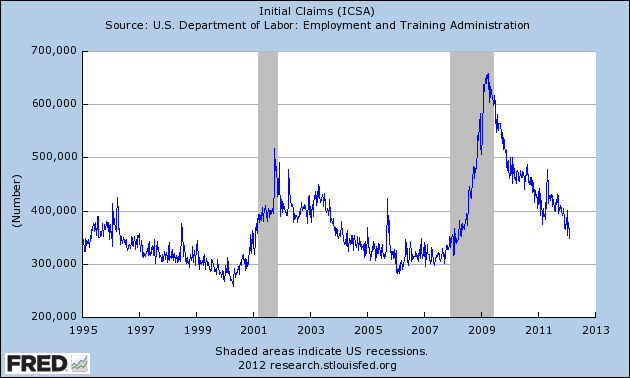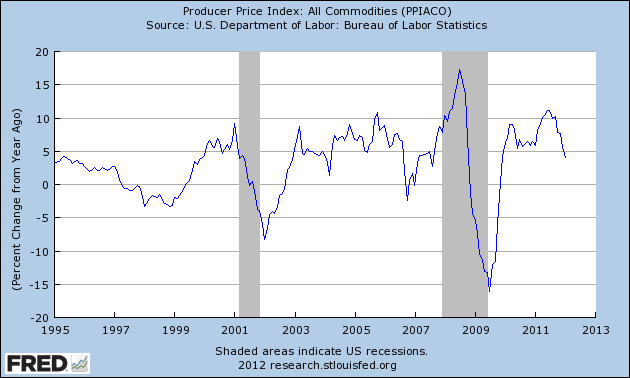-
Morning News: February 17, 2012
Posted by Eddy Elfenbein on February 17th, 2012 at 6:10 amGermany Seeks to Avoid Two-Step Vote on Greek Aid
Sarkozy Pledges Referendums at First Rally
ECB to Swap Greek Bonds for New Debt to Avoid Loss
U.K. Retail Sales Unexpectedly Rise on Household Goods
Regulators Make Nice as U.S. Banks Bristle Over Tough Examiners
Congress Will Auction Public Airwaves to Pay for Benefits
Moody’s Warns Big Banks of Possible Credit Rating Cuts
GM Earns Record Net Income While Fixing Opel Will Take Longer
Apple’s iPhone Loses China Market Share
Anglo American Profit Climbs 23% on Output
Icahn to Bid $2.6 Billion for CVR
Graff Diamonds Said to Prepare $1 Billion I.P.O. in Hong Kong
Yelp Expects Its I.P.O. to Price at $12 to $14 a Share
Doug Huber: Manufacturing In Decline?
Cullen Roche: The U.S.A. is Not the Roman Empire
Be sure to follow me on Twitter.
-
DirecTV’s Outlook for 2012 and 2013
Posted by Eddy Elfenbein on February 16th, 2012 at 11:54 pmTranscript from Seeking Alpha:
Next, I would like to make a few comments on our consolidated outlook. We expect to grow earnings per share to well over $4 this year, on pace to achieve our EPS target of at least $5 in 2013. Before interest and taxes, cash flow is expected to grow in the low double-digit range. However, free cash flow is likely to come in relatively flat compared with 2011, due mostly to our cash taxes, which will be higher in 2012, due to greater earnings and higher cash tax rate of 30% range, primarily related to the reversal of accelerated depreciation and benefits associated with prior year economic stimulus programs.
Finally, regarding our balance sheet, at this time, we still believe there are significant value in DIRECTV’s stock price, which merits our capital allocation strategy for share repurchases. Therefore, as Mike stated earlier, we expect to continue repurchasing shares at a pace of about $100 million per week. We also expect to opportunistically exit the debt markets in the near future. Once we get beyond 2012 with our balance sheet re-leveraging substantially completed, the level of buybacks will be based on a number of considerations, including strategic opportunities, our share price, leverage capacity and further investments in Latin America. If we accomplish all of these targets and deliver the expected financial results, I believe we will continue generating substantial shareholder value by leading the industry in revenue and earnings growth, as well as returning cash to shareholders.
The stock is at $45 which means it’s going for 11 times this year’s earnings and for nine times 2013’s.
-
DirecTV Beats by Ten Cents Per Share
Posted by Eddy Elfenbein on February 16th, 2012 at 3:25 pmBefore the opening bell this morning, DirecTV ($DTV) reported fourth-quarter earnings of $1.02 per share. That was ten cents more than Wall Street was expecting, and it’s a 38% increase over Q4 2010. After opening higher, the shares are currently down about 2% today.
The numbers show that DirecTV continues to do very well. The major issue for them is that it’s become more expensive to get new customers. That’s to be expected. For the fourth-quarter, DTV gained a net 125,000 subscribers in the United States which was less than Wall Street’s forecast. Comcast, however, is hemorrhaging subscribers. DirecTV continues to make major gains in Latin America. The company added 590,000 new subscribers in that region last quarter.
DirecTV also announced another $6 billion share buyback program. Frankly, that doesn’t impress me so much. I’d much rather have the company pay this money out to shareholders rather than hope for a capital gain. Plus, DirecTV just announced a slew of new equity awards for senior execs.
Again, I have no problem with the senior brass getting paid tons of money (as long as the company is well run). But just pay them in cash! There’s no need to do this two-step of giving them stock options and then trying to force the stock higher. It simply dilutes future earnings.
-
Malaysia Islamic Clerics Forbid Forex Trading
Posted by Eddy Elfenbein on February 16th, 2012 at 11:36 amVia Eclectic Linkfest I saw this story:
Malaysia Islamic clerics forbid forex trading
Malaysia’s highest Islamic body has issued an edict forbidding foreign exchange trading by Muslim individuals, saying such speculation violates Islamic law.
The National Fatwa Council ruled forex trading by money changers or between banks was allowable but trading by individuals “creates confusion” among the faithful, according to a report issued Wednesday by state news agency Bernama.
Council chairman Abdul Shukor Husin warned “there are many doubts about it (forex trading) and it involves individuals using the Internet, with uncertain outcomes,” Bernama reported.
“A study by the committee found that such trading involved currency speculation, which contradicts Islamic law,” he was quoted saying.
Forex and religion don’t have a great history. The only time Jesus used physical force is when he expelled the money-changers from the temple. Matthew 21:12-13:
And Jesus went into the temple of God, and cast out all of them who sold and bought in the temple, and overthrew the tables of the moneychangers, and the seats of them that sold doves,
And said unto them, It is written, My house shall be called the house of prayer; but ye have made it a den of thieves.
Skipping over any doctrinal issues, trading foreign currency is a terrible idea for individual investors. It’s a zero-sum game and you most likely won’t win.
You’ll notice that it’s always around forex that trading outfits style their sales pitches in order to lure in customers. If you’re saving for your retirement, trust me — stay away from forex.
-
“We Don’t Make Anything Anymore.” Really?
Posted by Eddy Elfenbein on February 16th, 2012 at 11:20 amOne of the biggest misconceptions about the U.S. economy is that we “don’t make anything anymore.” Not only is it not true, it’s very not true. The fact is that the United States is a manufacturing superpower. In the last 25 years, industrial production is up by more than 70%.
The difference, of course, is that far fewer people work in that sector. But that’s a big leap to say “we don’t make anything anymore.” We do. We’re just a lot more efficient.
-
More Good Economic News: Jobless Claims Fall to Four-Year Low
Posted by Eddy Elfenbein on February 16th, 2012 at 9:52 amWe had some more positive economic news. Or at least, a lack of terrible economic news. The Labor Department reported that first-time claims for unemployment benefits dropped to a seasonally adjusted 348,000. That’s the lowest number in four years. To give you some perspective, in 2009 jobless claims soared well over 600,000 a few times. Wall Street economists were expecting today’s report to be 365,000, so we’re running a little ahead of expectations. This is more evidence that the jobs market is slowly getting better.
The other good news is that wholesale prices rose by just 0.1% in January. Economists were expecting an increase of 0.4%. Wholesales prices actually fell by 0.1% in December. The takeaway is that inflation still isn’t a major problem for wholesalers. Typically, inflation shows up here first.
Still, we can’t say that there’s no threat of inflation down the road. Today’s report showed that the “core rate,” which excludes food and energy, rose by 0.4%. Economists like to look at the core rate because food and energy prices can be very volatile.
-
Morning News: February 16, 2012
Posted by Eddy Elfenbein on February 16th, 2012 at 5:37 amChina to Surpass India as Biggest Gold Market This Year, Council Predicts
Iran Warns 6 Countries in Europe It Will Cut Off Oil
For London Youth, Down and Out Is Way of Life
Oldest Swiss Private Bank is Newest U.S. Target
Summers, Clinton Lead Contenders for World Bank
Citigroup Whistle-Blower Says Bank’s ‘Brute Force’ Hid Bad Loans From U.S.
Morgan Stanley, UBS May Be Cut Up to Three Levels by Moody’s
Kellogg Wins Pringles After Diamond Deal Falls Apart
Nestle Sees 2012 Earnings Gain as Sales Beat
SocGen Fourth-Quarter Net Drops 89% on Investment Bank Loss
Renault Profit Stagnates as Europe Car Market Shrinks
French Distilling Giant Pernod Raises Annual Forecast After First-Half Profit Gains
Olympus Former Chairman and Six Others Arrested Over Fraud
Jeff Carter: The Price of A Gallon of Gas
Jeff Miller: Investors: Read a Lot, Get Squat!
Be sure to follow me on Twitter.
-
The Sports Illustrated Swimsuit Cover Indicator
Posted by Eddy Elfenbein on February 15th, 2012 at 4:28 pmCNBC has the stats on one of the more unusual stock market indicators: the Sports Illustrated Swimsuit Cover Indicator.
49 covers from 1964 until now:
* 25 blonde covers — average annual return of Dow 10 percent, S&P 10.9 percent
* Note: The covergirl from 2008, Marissa Miller, is a blonde and the Dow and S&P fell 34 and 39 percent, respectively
* 20 brunette covers — average annual return of Dow 2.2 percent, S&P 2.3 percent
* 3 covers with multiple models of varied hair color
* 1 cover with a redheadAdditionally, the models’ nationality may also yield an interesting result. Since 1978, the S&P 500 posted an average return of 14.3 percent when an American was on the cover of the magazine versus an 10.8 percent increase when a model from another country was selected, according to Bespoke Investment Group.
-
Nope, QE3 Still Ain’t Coming
Posted by Eddy Elfenbein on February 15th, 2012 at 2:26 pmI’m amazed how many people claim that the Federal Reserve is about to embark on a third round of bond buying (better known as quantitative easing or QE). This is despite the Fed’s repeated assertions that it’s not coming.
Just the other day, SocGen said that QE3 is coming soon. Even 36% of top economists think QE3 will come sometime this year.
Where do they get this idea?
Last June, I wrote a piece titled “Sorry Folks, QE3 Ain’t Coming.” and I feel like I have to say it again: QE3 ain’t coming.
The Fed released the minutes of its January meeting today. The media has latched on to a very minor mention of QE3:
A few members observed that, in their judgment, current and prospective economic conditions–including elevated unemployment and inflation at or below the Committee’s objective–could warrant the initiation of additional securities purchases before long. Other members indicated that such policy action could become necessary if the economy lost momentum or if inflation seemed likely to remain below its mandate-consistent rate of 2 percent over the medium run.
That’s it? That’s hardly anything. All it says is that “a few” members think QE3 could at some point be needed. That’s a giant leap from, “it’s coming.” Furthermore, the political backlash would be intense, especially during an election year.
The fact is that the employment outlook is (slowly) improving. There was never any real pressure for QE3 and whatever there was, has faded. I’m not saying whether it’s needed or not, but the idea that QE3 is coming is simply a pipedream.
-
The Market Is Doubting the Fed’s Timetable
Posted by Eddy Elfenbein on February 15th, 2012 at 10:26 amThe Federal Reserve has said that it doesn’t see itself raising interest rates until late 2014. Well, that’s fine and good. Guys in suits can say whatever they want, but the market often has other ideas. Right now, the market thinks a rate increase may come sooner than the Fed realizes.
As I’ve pointed out before, longer-term interest rates are slowly beginning to creep higher. For over three years, Benrnanke & Co. have kept overnight rates between 0% and 0.25%. Howard Packowitz at the WSJ notes that the futures market is doubting the Fed’s forecast:
Fed-funds futures Tuesday priced in a 90% chance for the FOMC to lift the funds rate to 0.5% at its meeting in late June 2014, from a 94% chance at Monday’s settlement.
An earlier rate hike is possible based on pricing of a shorter-dated contract. It priced in a 40% chance for a 0.5% rate after the late-January 2014 FOMC meeting, up from a 36% chance at Monday’s settlement.
It’s still too early to say exactly what the Fed will do, but I think it’s very possible that the Fed will move before late 2014. This changing market sentiment is also what’s leading investors to take on riskier assets (this is a theme I discussed in last week’s CWS Market Review). In the meantime, watch how cyclical stocks perform relative to the broader market. That will most likely be an early indicator of higher rates.
-
-
Archives
- April 2025
- March 2025
- February 2025
- January 2025
- December 2024
- November 2024
- October 2024
- September 2024
- August 2024
- July 2024
- June 2024
- May 2024
- April 2024
- March 2024
- February 2024
- January 2024
- December 2023
- November 2023
- October 2023
- September 2023
- August 2023
- July 2023
- June 2023
- May 2023
- April 2023
- March 2023
- February 2023
- January 2023
- December 2022
- November 2022
- October 2022
- September 2022
- August 2022
- July 2022
- June 2022
- May 2022
- April 2022
- March 2022
- February 2022
- January 2022
- December 2021
- November 2021
- October 2021
- September 2021
- August 2021
- July 2021
- June 2021
- May 2021
- April 2021
- March 2021
- February 2021
- January 2021
- December 2020
- November 2020
- October 2020
- September 2020
- August 2020
- July 2020
- June 2020
- May 2020
- April 2020
- March 2020
- February 2020
- January 2020
- December 2019
- November 2019
- October 2019
- September 2019
- August 2019
- July 2019
- June 2019
- May 2019
- April 2019
- March 2019
- February 2019
- January 2019
- December 2018
- November 2018
- October 2018
- September 2018
- August 2018
- July 2018
- June 2018
- May 2018
- April 2018
- March 2018
- February 2018
- January 2018
- December 2017
- November 2017
- October 2017
- September 2017
- August 2017
- July 2017
- June 2017
- May 2017
- April 2017
- March 2017
- February 2017
- January 2017
- December 2016
- November 2016
- October 2016
- September 2016
- August 2016
- July 2016
- June 2016
- May 2016
- April 2016
- March 2016
- February 2016
- January 2016
- December 2015
- November 2015
- October 2015
- September 2015
- August 2015
- July 2015
- June 2015
- May 2015
- April 2015
- March 2015
- February 2015
- January 2015
- December 2014
- November 2014
- October 2014
- September 2014
- August 2014
- July 2014
- June 2014
- May 2014
- April 2014
- March 2014
- February 2014
- January 2014
- December 2013
- November 2013
- October 2013
- September 2013
- August 2013
- July 2013
- June 2013
- May 2013
- April 2013
- March 2013
- February 2013
- January 2013
- December 2012
- November 2012
- October 2012
- September 2012
- August 2012
- July 2012
- June 2012
- May 2012
- April 2012
- March 2012
- February 2012
- January 2012
- December 2011
- November 2011
- October 2011
- September 2011
- August 2011
- July 2011
- June 2011
- May 2011
- April 2011
- March 2011
- February 2011
- January 2011
- December 2010
- November 2010
- October 2010
- September 2010
- August 2010
- July 2010
- June 2010
- May 2010
- April 2010
- March 2010
- February 2010
- January 2010
- December 2009
- November 2009
- October 2009
- September 2009
- August 2009
- July 2009
- June 2009
- May 2009
- April 2009
- March 2009
- February 2009
- January 2009
- December 2008
- November 2008
- October 2008
- September 2008
- August 2008
- July 2008
- June 2008
- May 2008
- April 2008
- March 2008
- February 2008
- January 2008
- December 2007
- November 2007
- October 2007
- September 2007
- August 2007
- July 2007
- June 2007
- May 2007
- April 2007
- March 2007
- February 2007
- January 2007
- December 2006
- November 2006
- October 2006
- September 2006
- August 2006
- July 2006
- June 2006
- May 2006
- April 2006
- March 2006
- February 2006
- January 2006
- December 2005
- November 2005
- October 2005
- September 2005
- August 2005
- July 2005





 Eddy Elfenbein is a Washington, DC-based speaker, portfolio manager and editor of the blog Crossing Wall Street. His
Eddy Elfenbein is a Washington, DC-based speaker, portfolio manager and editor of the blog Crossing Wall Street. His